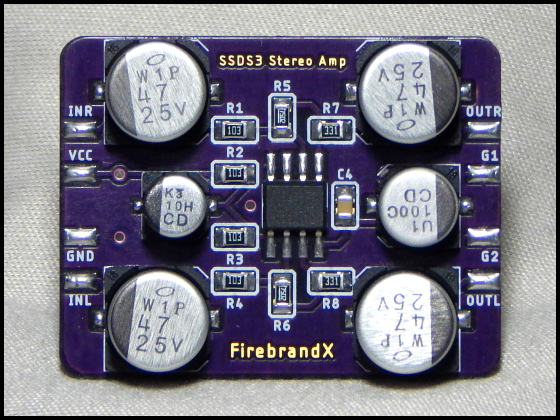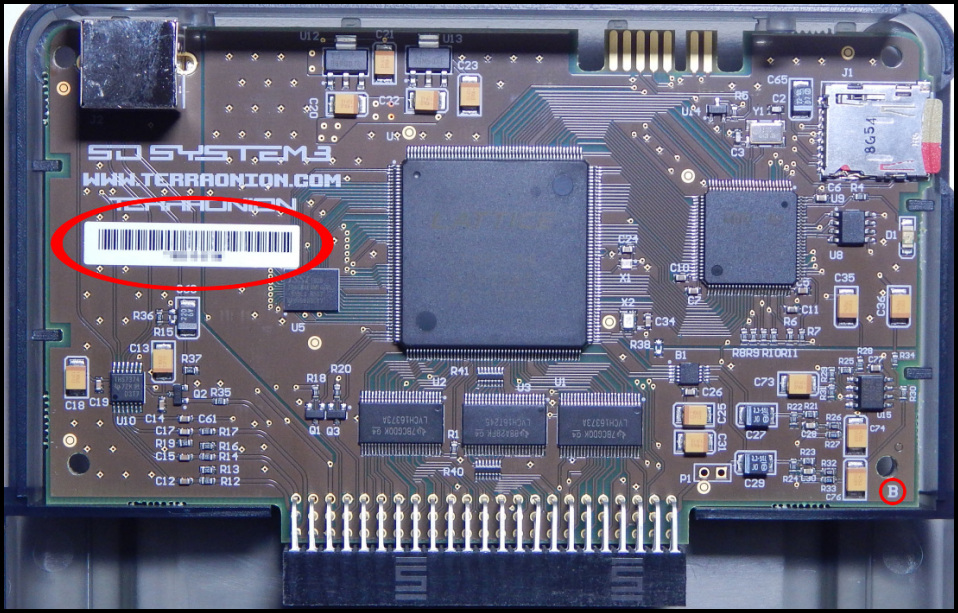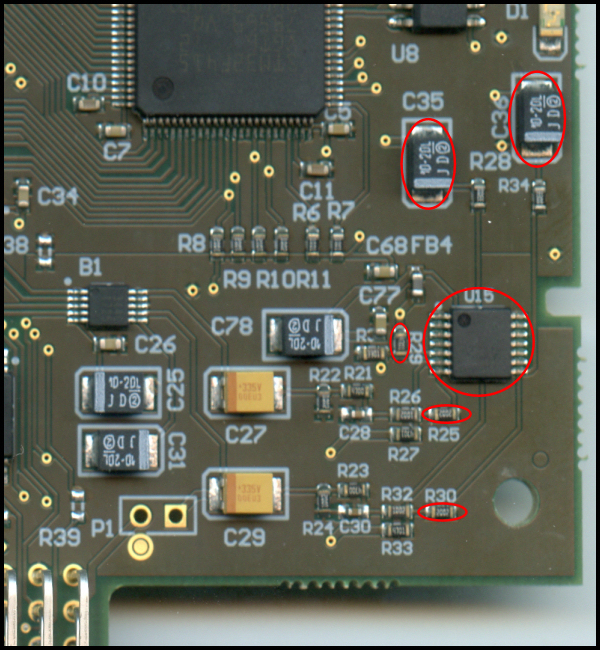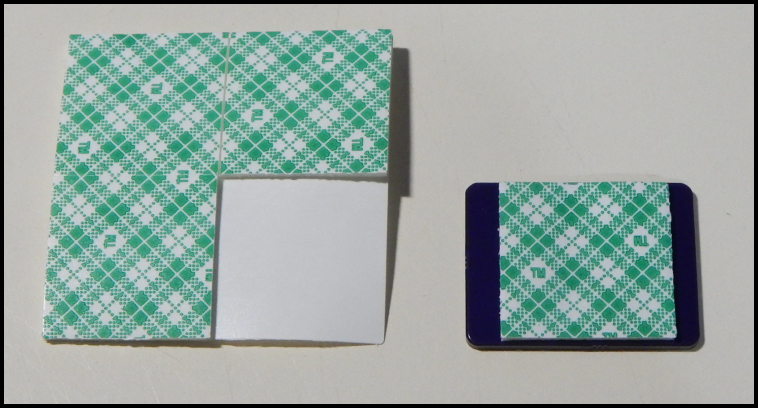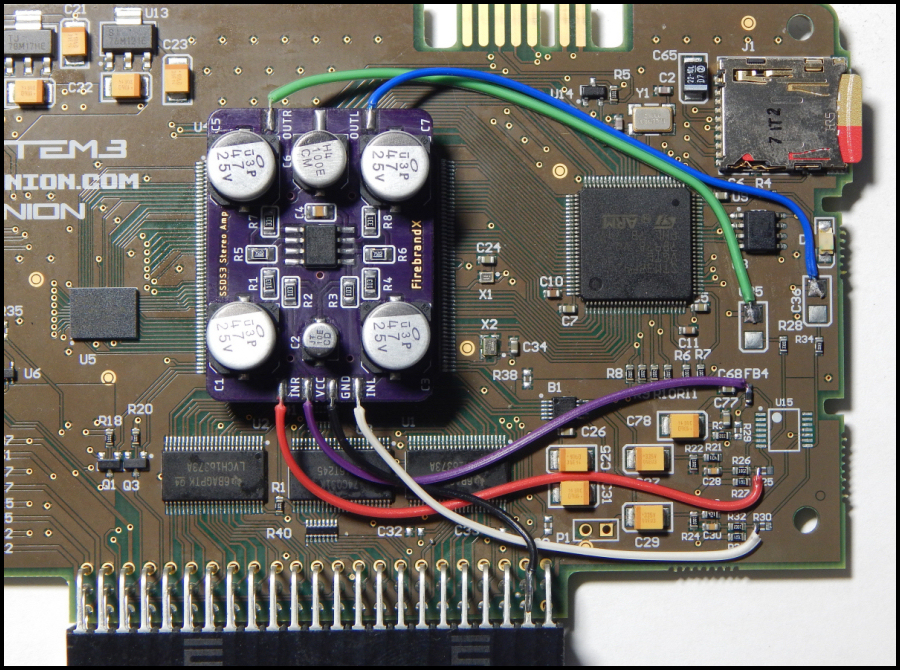|
SSDS3 Stereo Bypass Amp Mod Board
This bypass op-amp board replaces the default op-amp & circuitry to create clean and balanced stereo audio output. It corrects some flaws that were found in original SSDS3 boards, as well as newly discovered flaws in all SSDS3 boards currently sold by Terra Onion:
1.) Bypass board includes a quality Nichicon polarized electrolytic Vref cap for the cleanest possible sound.
Below is a link to my Youtube video demonstration of the bypass board in action at max CD volume. I go into more detail about the advantages of installing and using this mod in the SSDS3:
SSDS3 2019 "Rev B" Revision Notice: Please note which version of the SSDS3 board you have before ordering any mods for it! Starting in December of 2018, TerraOnion intetgrated both Voultar's video circuit mod and my audio circuit mod into the SSDS3 board itself. Below is a picture of this new revision. If you see a white sticker bard code as shown below and the revison letter "B" in the lower right-hand corner of the board (both circled in red), you do NOT need any mod work done on your SSDS3:
You can order the board plates from OSH Park (which also includes a Bill of Materials so you can select the parts for assembly from your favorite electronics supply dealer). I will no longer be making these boards as I need to move on to bigger and better projects: SSDS3 Stereo Bypass Amp Example Installation Guide: Note: The effectiveness of this mod will depend on the quality of RGB cables you use in the mini-DIN jack. Cheap cables that lack shielding for the audio lines will cause the nasty video signals to couple over into the audio and re-introduce buzz & hum. So please try to get quality coaxial shielded cables from Retro-Access (Genesis Model 2 Style), or use HD Redtrovision Genesis cables for YPbPr output. Here's a Youtube video PSA I did on how the effectiveness of this board can be hampered by using poor quality cheap A/V cables: Youtube Video PSA on Bad A/V cables Alternatively, You can choose to run separate lines straight from the output of the mod board to RCA jacks by routing the wires around the outside of the mini-DIN box and out the port hole of the backplate. I myself went the extra mile of drilling holes for RCA jacks in the backplate itself, but do this at your own risk as it requires expert craftsmanship and requires soldering up the RCA jacks BEFORE you install them into the backplate. Heat transfer will crack the plastic of the backplate if you attempt to solder the jacks while they are secured to it. Another modder went with a mini-headphone jack that he drilled a single hole for and secured the output lines to it. If you intend to use Voultar's FU-RGB board, I'd just stick to the standard installation that routes the lines back into the mini-DIN jack.
Step 1:
This mod requires experience in cleanly desoldering surface mount components and IC's. I personally use high quality desoldering wick to remove the majority of the solder on these parts, and then I use a hot air station heat the components while gently lifting with electronics tweezers. You can find videos on Youtube of this technique, especially on Voultar's channel. When using a hot air station like the W.E.P. 858D, I don't recommend going any higher than 400 degrees. As shown in several of Voultar's videos, you want to use gental circular motions around all the legs you want to heat up. In my case, I grasp the part with electronics tweezers while doing this and let gravity pull the board away from the part while holding it an inch or so off the work table. Afterwords, clean up the exposed pads with some more desoldering wick and hot iron. Then use a toothbrush dipped in rubbing alcohol (higher percentage the better) to clean the areas of any remaining wick residue.
Right, so below are the parts that need to be removed from the board circled in red:
Step 2:
Now take a square of Scotch mounting pad, peel the white sticker side, and affix the pad to the BOTTOM of the mod board as seen below (note the board in the photo is unpopulated, but you get the idea):
Step 3:
Peel off the plaid side of the Scotch mounting pad and firmly affix the mod board to the top of the main center chip in the SSDS3. Now it's just a simple matter of soldering wires to the pads as shown in the photo below:
If you need more specific details on wiring locations, below is the list of pad designations you need to solder to:
"OUTR" goes to top pad of "C35".
Note: The outputs from my mod board in this installation do not require a ground line. This is because the mini-DIN socket of the SSDS3 uses the analog ground pin on the video side of the board to assign ground to audio as well. However, when using your own independant output lines from the bypass board, you will need to solder on at least one ground wire for the Stereo lines to share. My new revision of the board show at the top of this page (which will be the version sold hence forth) has two independent ground output lines at your disposal.
|

